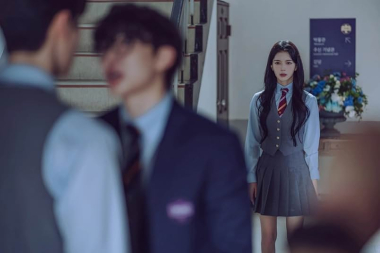Hierarchy Review
An In-Depth Reflection on Hierarchy
The film Hierarchy is an intricate exploration of human ambition, social structures, and the cascading influences of power within contemporary society. As a dedicated film enthusiast who has dedicated countless evenings to both indie gems and large-scale productions, I found this movie to be a thoroughly engaging narrative that challenges the norms of storytelling while presenting a rich tapestry of characters whose lives intersect in unexpected ways. Throughout its runtime, Hierarchy provides a remarkable commentary on how individuals navigate the unseen chains of responsibility and legacy within a society laden with implicit hierarchies.
A Complex Narrative That Unfolds with Precision
From the opening scene, Hierarchy establishes its distinct narrative style, providing viewers with a critical lens through which we observe the interplay of societal expectations and personal aspirations. The film doesn’t simply follow a linear storyline; it instead employs a layered approach where every scene is a node in a broader network of interconnected events. At times the narrative may seem unconventional, deliberately challenging traditional cinematic structures, but this is precisely what makes the storyline so refreshing and intellectually stimulating.
One aspect that stands out is the director’s audacious choice to merge realism and symbolic imagery. The film oscillates between almost documentary-like realism and allegorical sequences that provide deeper insights into the internal and external conflicts faced by its characters. The fluidity between varying styles is maintained through a deliberate pace that invites the audience to invest emotionally and intellectually in each twist and turn. This is not a film designed for sheer entertainment; it is an invitation to reflect on the intricate layers of social dynamics, corporate machinations, and the personal sacrifices that underpin the quest for success.
Memorable Performances and Character Arcs
Hierarchy thrives on its robust ensemble cast, each actor painting a vivid picture of their role in this stratified society. The protagonist, whose internal dilemmatic journey forms the backbone of the narrative, delivers a performance that is at once subtle and fiercely compelling. His character’s progression from a hopeful optimist to a resolute individual hardened by systemic challenges is portrayed through a nuanced expression of vulnerabilities and motivations.
Supporting characters are equally well-cast, adding complexity and depth to the storyline. The intricate weave of relationships – both personal and professional – is captured with sincerity, reflecting genuine human experiences that resonate on multiple levels. Each performance contributes to a layered portrait of society, with every glance and interaction hinting at larger truths hidden beneath the surface of everyday life. A key element is the film’s ability to depict internal conflict without resorting to melodrama, achieving a balance that emphasizes realism.
Visual and Auditory Brilliance
The cinematographic choices in Hierarchy are deliberate and evocative. The palette shifts with the narrative, often mirroring the internal states of the characters. When emotion spikes or the consequences of a character’s decision become palpable, the lighting transitions seamlessly from muted tones to a more vibrant hue, reinforcing the weight of the moment for the viewer. This visual storytelling is coupled with an arresting soundtrack that moves effortlessly between reflective, minimalistic compositions and more intense, pulsating rhythms during moments of heightened tension.
The use of natural light and shadow is particularly noteworthy. Rather than overpower the narrative with excessive visual flair, the film leans into subtlety, allowing viewers to become active participants in interpreting visual metaphors. This delicate interplay of visuals helps to illustrate the internal hierarchies within individuals as well as those ingrained by society.
Thematic Depth and Social Critique
Hierarchy succeeds at being both an artistic endeavor and a social critique. At its core, the film poses critical questions about the nature of authority, the sometimes arbitrary divisions that separate people by class, and the inherent struggle for recognition within both personal realms and professional spheres. There is a raw honesty in the portrayal of the societal ladder, where every character must contend with the expectations placed upon them by a structure that often feels impossible to navigate.
This thematic exploration is handled with subtlety rather than overt didacticism. Instead of preaching a singular moral, the film encourages audiences to contemplate the implications of hierarchical pressures in their own lives. The dialogue is rich with introspection and philosophical queries, inviting viewers to watch, to stream, and even to download and share insights about the very fabric of modern communities. The approach is both methodical and organic, culminating in a narrative that is as intellectually demanding as it is visually arresting.
Interwoven into this critique are elements of hope and redemption. Through carefully constructed narrative arcs, the film acknowledges that while societal frameworks can be oppressive, they also offer a platform for change. The journey from despair to empowerment, though fraught with setbacks, is portrayed as a natural consequence of human resilience. There is a subtle optimism about the potential for reformation—not by dismantling the system entirely, but by reframing our perception of what it means to be a part of it.
Exploring the Layers of Relationships
One of the film's most compelling aspects is its portrayal of interpersonal relationships. In Hierarchy, every character represents a facet of the larger social machine. Relationships are complex and not easily defined by conventional labels such as friend or foe. Instead, the narrative paints them in shades of gray, emphasizing how even the most conflicting interactions can lead to mutual growth and understanding. This portrayal is refreshingly realistic and mirrors the intricate ways our own lives are woven with conflicting loyalties and perspectives.
The film sensitively handles romantic subplots and platonic bonds alike, each unfolding with a careful balance of tension and tenderness. By doing so, the film reminds viewers that behind every act of defiance against societal norms lies a personal story of love, loss, and the relentless drive to carve out a place for oneself in a world governed by unsaid rules. These deeply personal moments stand in stark contrast to the broader societal commentary, yet they are intrinsically connected through the common thread of human aspiration and struggle.
Subtle Symbolism in Storytelling
Hierarchy employs subtle symbolism throughout its narrative, making it a treasure trove for viewers who appreciate layered storytelling that invites varied interpretations. The physical settings themselves serve as powerful symbols; grand buildings and oppressive, crowded urban landscapes stand in metaphoric contrast to the inner lives of the characters. Much like a meticulously designed chessboard, the film presents each element as a move in a much larger game—a game that critiques the self-imposed limitations and externally enforced hierarchies of modern society.
Notably, the director’s penchant for embedding symbolic gestures within mundane interactions is evident in several key moments. A simple exchange of glances, a lingering shot of a bustling street, or even the nuanced depiction of a minor character’s background story all contribute to a broader context that enriches the viewing experience. Rather than relying on overt narration, Hierarchy trusts its audience to discern these subtleties, thereby engaging them in a dialogue that transcends the screen.
The Technical Craftsmanship Behind Hierarchy
Behind the scenes, Hierarchy’s production quality is of an exceptionally high standard, a clear testament to the director’s vision and the crew’s commitment to excellence. Every technical choice—be it the fluid camera movements or the ambient sound design—has been meticulously thought out to enhance the storytelling. The careful attention to detail in the production design is evident in the settings, costumes, and even in the deliberate use of color schemes that shift to support the emotional tone of the narrative.
Equally impressive is the film’s editing, which itself is a study in restraint and precision. Fast-paced cuts alternate with long, lingering shots, creating a rhythm that guides viewers through an oscillation of tension and calm. There is a palpable sense of immersion that is intentionally cultivated, inviting the audience to not just watch the film, but to stream and download each scene into their memory. This technical mastery enriches the audience’s engagement, ensuring that every frame leaves a lasting impact on both their consciousness and aesthetic appreciation.
Implications on Contemporary Cinema
Hierarchy has established itself as a pioneering work, particularly in an era where films are increasingly focused on spectacle over substance. In contrast, this film dares to be contemplative, addressing pertinent themes in a manner that is both artistic and profoundly relevant to contemporary social debates. Its approaches to character development and narrative complexity are a refreshing divergence from formulaic plotlines, particularly in a cinematic landscape dominated by reboots and sequels.
The film manages to challenge its viewers while simultaneously offering a mirroring reflection of the modern human condition. It insists on a depth of analysis, urging viewers to examine their own positions within the structures and institutions that shape their everyday lives. This film is not merely something to watch or stream for diversion; it is a sophisticated commentary that invites an intellectual and emotional response, leaving a lasting impression that encourages ongoing dialogue and reflection.
In the final analysis, Hierarchy is a masterful examination of the power structures that define social existence. It is a movie that rewards patience and engagement, inviting its audience to look beyond superficial narratives and to download a deeper understanding of the interplay between individual ambition and systemic control. The film’s distinctive approach and profound insights ensure that it remains accessible to both casual viewers and dedicated cinephiles. For those interested in the art of cinema that seamlessly weaves thematic intelligence with technical innovation, Hierarchy is a must-watch piece that continues to resonate well after the closing credits.
Final Thoughts
In an age where streaming platforms offer a constant bombardment of content, Hierarchy distinguishes itself as a thoughtful and provocative piece of filmmaking. Its unblocked narrative, rich symbolism, and expertly executed technical features converge to create an enduring cinematic experience. Whether you choose to watch, stream, download, or simply find it free to view on select online portals, Hierarchy challenges its audience to confront the implicit structures that govern our lives, both in society and within ourselves.
The film’s dialogue, cinematography, and layered storylines collectively offer a nuanced, reflective experience that is ideally suited for film enthusiasts looking for something substantial amid the endless digital flow of content. With its admirable artistic courage and critical examination of contemporary life, Hierarchy not only provides an engrossing viewing experience but also serves as an invitation to question and redefine the assumptions that lie at the core of our social organization. For those who appreciate cinema that is as demanding intellectually as it is beautiful in execution, Hierarchy is an outstanding testament to the transformative power of well-crafted film.
How to watch Hierarchy online
Hierarchy is currently available on multiple online platforms, allowing you to watch or stream it from the comfort of your home. Certain options may provide the film for free, while others require a subscription or rental fee. For those who prefer to download and view content offline, there are platforms that offer download facilities within the guidelines of their service agreements. The American age rating for Hierarchy is PG-13, which means it is not recommended for children under 13 without parental guidance.
On major streaming platforms, Netflix offers a trial period during which you might explore the film and possibly download it for offline viewing. Amazon Prime Video provides options to rent or purchase Hierarchy, typically backed by a free trial period and offline access after download. If you prefer Apple TV, the movie is available to purchase or rent with high-quality streaming and download options. Peacock distinguishes between free and premium models with varying conditions for downloads, while Hulu also makes the movie available under a trial basis with some download restrictions. Additionally, YouTube Movies provides an accessible option to rent or buy the film, with download through the app available for enhanced flexibility.
Screenshots






Leave a comment
Your comment is awaiting moderation. We save your draft here
0 Comments